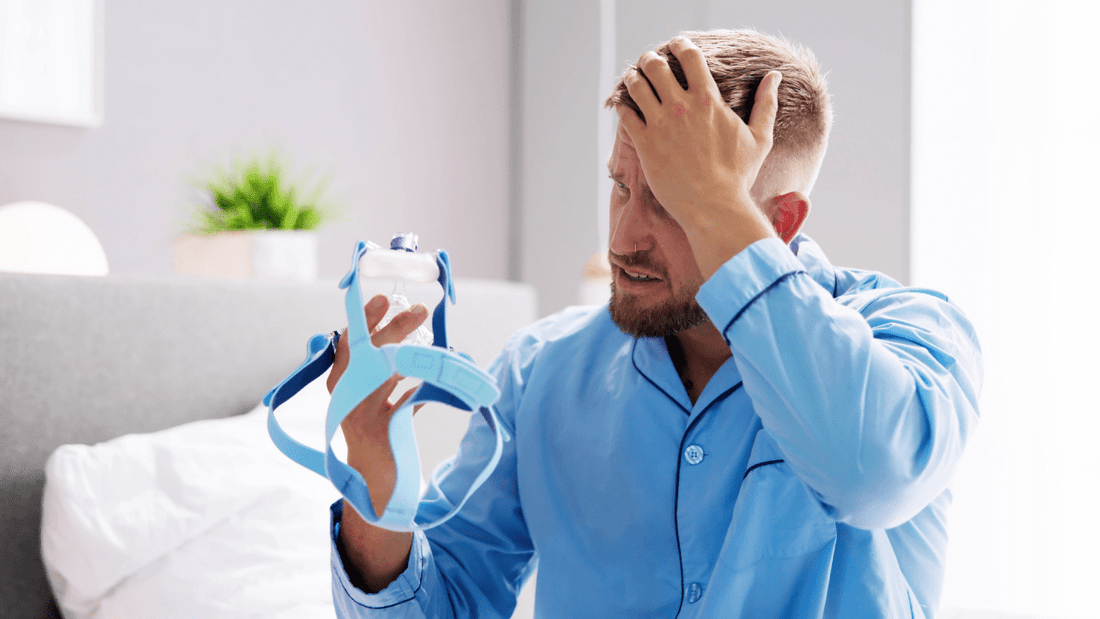
APAP vs CPAP: Choosing the Right Sleep Apnea Therapy for You
For people with sleep apnea, positive airway pressure (PAP) therapy is a common and effective treatment option. PAP therapy delivers a steady stream of air through a mask to keep the airways open during sleep, helping people avoid pauses in breathing, or apneas. Continuous Positive Airway Pressure (CPAP) and Automatic Positive Airway Pressure (APAP) are two of the most popular devices for this purpose, each with unique benefits for different needs. Understanding the differences between APAP and CPAP can help patients work with their healthcare providers to choose the right machine for their sleep apnea therapy.
What is CPAP?
CPAP stands for Continuous Positive Airway Pressure, which provides a steady, continuous stream of air at a fixed pressure. When you wear a CPAP mask at night, the CPAP machine delivers air to help keep your airway open, preventing pauses in breathing that can disrupt your sleep and health.
The primary feature of CPAP is that the pressure level is set based on a prescription from your sleep specialist, and it remains constant throughout the night. While CPAP therapy is effective for treating obstructive sleep apnea (OSA), some patients find it challenging to adjust to the continuous airflow, particularly if their pressure needs change throughout the night.
What is APAP?
APAP stands for Automatic Positive Airway Pressure (also known as AutoPAP or Auto CPAP). Unlike CPAP, APAP machines adjust the pressure automatically based on your needs. These machines use algorithms and sensors to detect changes in airflow and adjust pressure levels as you sleep, which makes APAP machines more flexible for people with variable pressure needs. APAP therapy can be particularly beneficial for patients whose breathing requirements fluctuate throughout the night due to factors like body position, REM sleep stages, or weight changes.
Difference Between APAP and CPAP
The core difference between APAP and CPAP lies in how they deliver air pressure. Here’s a breakdown of the main differences:
- Pressure Delivery:
- CPAP delivers a fixed air pressure set by a healthcare provider.
- APAP adjusts the air pressure automatically in response to changes in your breathing patterns.
- Comfort:
- Some patients find APAP therapy more comfortable since it reduces air pressure during less intense breathing periods and increases it as needed.
- CPAP therapy offers consistent pressure, which may cause discomfort for people with fluctuating pressure needs but can work well for those with stable breathing patterns.
- Flexibility:
- APAP machines provide flexibility, making them ideal for people whose sleep apnea worsens under certain conditions, like seasonal allergies, sinus issues, or sleeping on their back.
- CPAP machines may be more effective for patients with consistent pressure needs, and many people become accustomed to the single-setting pressure.
|
Therapy Type |
Pressure Type |
Best Suited For |
|
CPAP |
Fixed |
Consistent OSA without pressure variation needs |
|
APAP |
Automatic |
Variable breathing needs due to position or REM sleep |
When Should You Consider APAP vs CPAP?
Choosing between APAP and CPAP depends on individual needs, comfort, and the recommendations of a sleep specialist. Here are some factors to consider:
- Varied Breathing Needs: If you experience breathing changes due to allergies, nasal congestion, or sleeping position, AutoPAP might be a better choice because of its pressure adjustment capability.
- Difficulty with Fixed Pressure: For those who struggle with constant pressure from a CPAP machine, an APAP machine can offer relief by reducing the pressure when it’s not needed as much, making it more comfortable.
- Trial Periods: Many providers offer trial periods with APAP machines to see if a variable pressure setting feels more comfortable. Your doctor may recommend trying APAP first to determine whether it can effectively address your needs.
How Does APAP Therapy Work?
An APAP machine operates by monitoring your breathing through a series of sensors and algorithms that adjust air pressure based on real-time needs. Here’s how APAP therapy functions:
- Initial Detection: The APAP machine starts at a low pressure and increases only as needed, detecting signs of restricted airflow.
- Adjustment in Pressure: When the machine detects that your airway is becoming blocked, it increases the pressure to prevent apnea.
- Continuous Monitoring: Throughout the night, the APAP machine continually monitors airflow, adjusting the pressure to ensure your airway remains open without excessive or uncomfortable pressure.
This automatic adjustment feature is highly effective for people whose sleep apnea severity fluctuates, helping to maintain comfort while ensuring effective apnea treatment.
APAP Machines and Supplies
While CPAP supplies such as masks, tubing, and filters are similar across both machine types, some unique accessories may enhance the experience of APAP users:
- APAP Mask: APAP machines often work best with masks that allow for a full range of motion, like nasal or full-face masks.
- CPAP Headgear: A comfortable fit is essential in APAP therapy, especially since the machine adjusts pressure through the night. CPAP headgear with adjustable straps can provide added comfort.
- CPAP Humidifier: Many APAP machines come with built-in humidifiers to prevent airway dryness, an added benefit when pressures fluctuate throughout the night.
Auto CPAP vs CPAP: Which is More Effective?
Both CPAP and APAP are highly effective for sleep apnea treatment, but they serve slightly different purposes:
- Consistency in Treatment: CPAP remains highly effective for people with stable and straightforward OSA.
- Personalized Adjustments: APAP’s ability to adjust pressure levels automatically makes it a strong contender for people who experience variable apnea symptoms.
- Cost and Insurance: While APAP machines tend to be pricier than CPAP machines, insurance plans often cover both devices based on a doctor’s prescription, allowing you to choose the one that best fits your medical needs.
